This document provides an introduction and overview of XML. It defines XML, explains how it is used to transport and store data, and compares it to HTML. It provides examples of XML code and documents. It describes XML syntax rules including requirements for closing tags, nesting, and attributes. It explains how XML documents form a tree structure and defines key XML concepts like elements, attributes, comments and naming conventions.
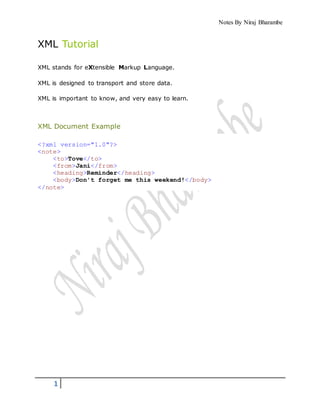










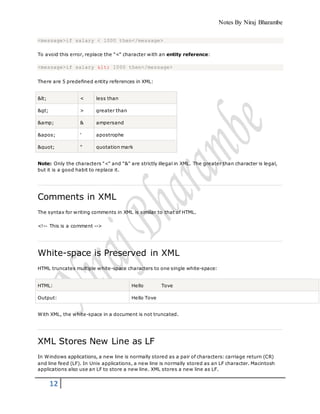





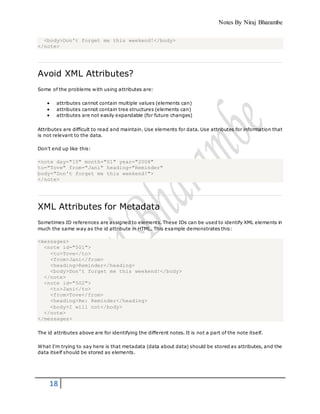

![Notes By Niraj Bharambe
20
XML DTD
The purpose of a DTD is to define the structure of an XML document. It defines the structure with a
list of legal elements:
<!DOCTYPE note
[
<!ELEMENT note (to,from,heading,body)>
<!ELEMENT to (#PCDATA)>
<!ELEMENT from (#PCDATA)>
<!ELEMENT heading (#PCDATA)>
<!ELEMENT body (#PCDATA)>
]>
If you want to study DTD, you will find our DTD tutorial on our homepage.
XML Schema
W3C supports an XML-based alternative to DTD, called XML Schema:
<xs:element name="note">
<xs:complexType>
<xs:sequence>
<xs:element name="to" type="xs:string"/>
<xs:element name="from" type="xs:string"/>
<xs:element name="heading" type="xs:string"/>
<xs:element name="body" type="xs:string"/>
</xs:sequence>
</xs:complexType>
</xs:element>
If you want to study XML Schema, you will find our Schema tutorial on our homepage.
A General XML Validator
To help you check the syntax of your XML files, we have created an XML validator to syntax-check
your XML.
Please see the next chapter.](https://image.slidesharecdn.com/xml-150323102007-conversion-gate01-150606072724-lva1-app6892/85/Xml-150323102007-conversion-gate01-20-320.jpg)

![Notes By Niraj Bharambe
22
Filename:
http://w w w .w 3schools.com/xml/note_error.xml
Validate
Note: If you get an "Access denied" error, it's because your browser security does not allow file
access across domains.
The file "note_error.xml" demonstrates your browsers error handling. If you want to see an error free
message, substitute the "note_error.xml" with "cd_catalog.xml".
Validate Your XML Against a DTD
If you run Internet Explorer, you can validate your XML against a DTD in the text area below.
Just add the DOCTYPE declaration (with the DTD) after the <xml> element, and click the "Validate"
button:
<?xml version="1.0" ?>
<!DOCTYPEnote [
<!ELEMENT note (to,from,heading,body)>
<!ELEMENT to (#PCDATA)>
<!ELEMENT from (#PCDATA)>
<!ELEMENT heading (#PCDATA)>
<!ELEMENT body (#PCDATA)>
]>
<note>
<to>Tove</to>
<from>Jani</from>
<heading>Reminder</heading>
<message>Don't forget me this w eekend!</message>
</note>](https://image.slidesharecdn.com/xml-150323102007-conversion-gate01-150606072724-lva1-app6892/85/Xml-150323102007-conversion-gate01-22-320.jpg)



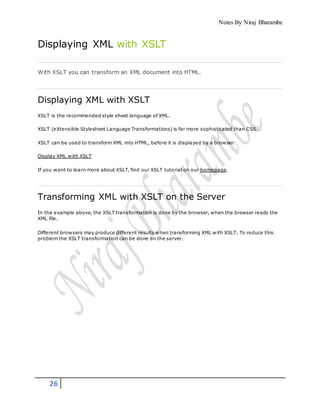

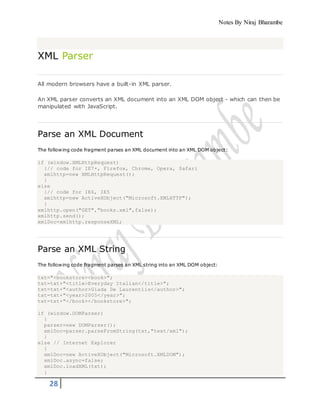


![Notes By Niraj Bharambe
31
if (window.XMLHttpRequest)
{// code for IE7+, Firefox, Chrome, Opera, Safari
xmlhttp=new XMLHttpRequest();
}
else
{// code for IE6, IE5
xmlhttp=new ActiveXObject("Microsoft.XMLHTTP");
}
xmlhttp.open("GET","note.xml",false);
xmlhttp.send();
xmlDoc=xmlhttp.responseXML;
document.getElementById("to").innerHTML=
xmlDoc.getElementsByTagName("to")[0].childNodes[0].nodeValue;
document.getElementById("from").innerHTML=
xmlDoc.getElementsByTagName("from")[0].childNodes[0].nodeValue;
document.getElementById("message").innerHTML=
xmlDoc.getElementsByTagName("body")[0].childNodes[0].nodeValue;
</script>
</body>
</html>
Try it yourself »
Important Note!
To extract the text "Tove" from the <to> element in the XML file above ("note.xml"), the syntax is:
getElementsByTagName("to")[0].childNodes[0].nodeValue
Notice that even if the XML file contains only ONE <to> element you still have to specify the array
index [0]. This is because the getElementsByTagName() method returns an array.
Load an XML String - Cross-browser Example
The following example parses an XML string into an XML DOM object and then extracts some info from
it with a JavaScript:
Example
<html>
<body>
<h1>W3Schools Internal Note</h1>
<div>
<b>To:</b> <span id="to"></span><br />
<b>From:</b> <span id="from"></span><br />
<b>Message:</b> <span id="message"></span>
</div>](https://image.slidesharecdn.com/xml-150323102007-conversion-gate01-150606072724-lva1-app6892/85/Xml-150323102007-conversion-gate01-31-320.jpg)
![Notes By Niraj Bharambe
32
<script>
txt="<note>";
txt=txt+"<to>Tove</to>";
txt=txt+"<from>Jani</from>";
txt=txt+"<heading>Reminder</heading>";
txt=txt+"<body>Don't forget me this weekend!</body>";
txt=txt+"</note>";
if (window.DOMParser)
{
parser=new DOMParser();
xmlDoc=parser.parseFromString(txt,"text/xml");
}
else // Internet Explorer
{
xmlDoc=new ActiveXObject("Microsoft.XMLDOM");
xmlDoc.async=false;
xmlDoc.loadXML(txt);
}
document.getElementById("to").innerHTML=
xmlDoc.getElementsByTagName("to")[0].childNodes[0].nodeValue;
document.getElementById("from").innerHTML=
xmlDoc.getElementsByTagName("from")[0].childNodes[0].nodeValue;
document.getElementById("message").innerHTML=
xmlDoc.getElementsByTagName("body")[0].childNodes[0].nodeValue;
</script>
</body>
</html>](https://image.slidesharecdn.com/xml-150323102007-conversion-gate01-150606072724-lva1-app6892/85/Xml-150323102007-conversion-gate01-32-320.jpg)
![Notes By Niraj Bharambe
33
XML in HTML
Display XML Data in an HTML Page
In the following example, we open an XML file ("cd_catalog.xml"), then we loop through each CD
element, and display the value of the ARTIST element and the TITLE element in an HTML table:
Example
<html>
<body>
<script>
if (window.XMLHttpRequest)
{// code for IE7+, Firefox, Chrome, Opera, Safari
xmlhttp=new XMLHttpRequest();
}
else
{// code for IE6, IE5
xmlhttp=new ActiveXObject("Microsoft.XMLHTTP");
}
xmlhttp.open("GET","cd_catalog.xml",false);
xmlhttp.send();
xmlDoc=xmlhttp.responseXML;
document.write("<table border='1'>");
var x=xmlDoc.getElementsByTagName("CD");
for (i=0;i<x.length;i++)
{
document.write("<tr><td>");
document.write(x[i].getElementsByTagName("ARTIST")[0].childNodes[0].nodeValue
);
document.write("</td><td>");
document.write(x[i].getElementsByTagName("TITLE")[0].childNodes[0].nodeValue)
;
document.write("</td></tr>");
}
document.write("</table>");
</script>
</body>
</html>](https://image.slidesharecdn.com/xml-150323102007-conversion-gate01-150606072724-lva1-app6892/85/Xml-150323102007-conversion-gate01-33-320.jpg)
![Notes By Niraj Bharambe
34
XML Applications
This chapter demonstrates some small XML applications built on XML, HTML, XML DOM
and JavaScript.
The XML Document Used
In this application we will use the "cd_catalog.xml" file.
Display the First CD in an HTML div Element
The following example gets the XML data from the first CD element and displays it in an HTML element
with id="showCD". The displayCD() function is called when the page is loaded:
Example
x=xmlDoc.getElementsByTagName("CD");
i=0;
function displayCD()
{
artist=(x[i].getElementsByTagName("ARTIST")[0].childNodes[0].nodeValue);
title=(x[i].getElementsByTagName("TITLE")[0].childNodes[0].nodeValue);
year=(x[i].getElementsByTagName("YEAR")[0].childNodes[0].nodeValue);
txt="Artist: " + artist + "<br />Title: " + title + "<br />Year: "+ year;
document.getElementById("showCD").innerHTML=txt;
}
Try it yourself »
Navigate Between the CDs
To navigate between the CDs, in the example above, add a next() and previous() function:
Example
function next()
{ // display the next CD, unless you are on the last CD
if (i<x.length-1)
{
i++;
displayCD();
}](https://image.slidesharecdn.com/xml-150323102007-conversion-gate01-150606072724-lva1-app6892/85/Xml-150323102007-conversion-gate01-34-320.jpg)

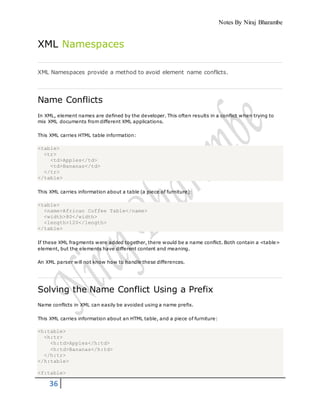



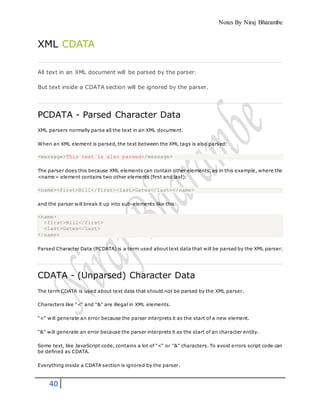
![Notes By Niraj Bharambe
41
A CDATA section starts with "<![CDATA[" and ends with "]]>":
<script>
<![CDATA[
function matchwo(a,b)
{
if (a < b && a < 0) then
{
return 1;
}
else
{
return 0;
}
}
]]>
</script>
In the example above, everything inside the CDATA section is ignored by the parser.
Notes on CDATA sections:
A CDATA section cannot contain the string "]]>". Nested CDATA sections are not allowed.
The "]]>" that marks the end of the CDATA section cannot contain spaces or line breaks.](https://image.slidesharecdn.com/xml-150323102007-conversion-gate01-150606072724-lva1-app6892/85/Xml-150323102007-conversion-gate01-41-320.jpg)
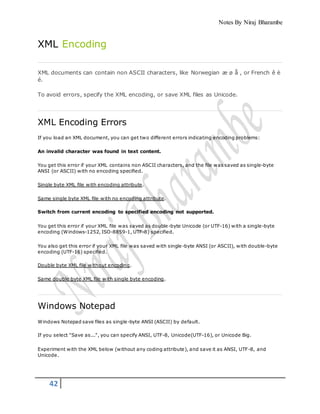
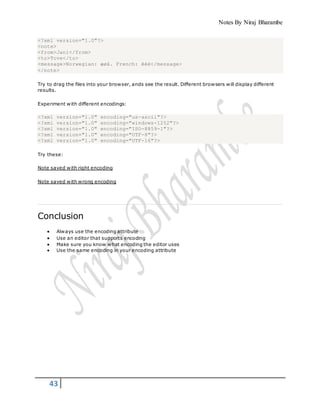



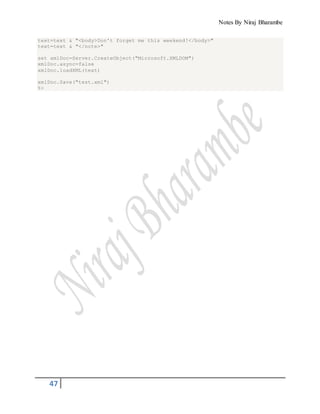
![Notes By Niraj Bharambe
48
XML DOM Advanced
The XML DOM - Advanced
In an earlier chapter of this tutorial we introduced the XML DOM, and we used the
getElementsByTagName() method to retrieve data from an XML document.
In this chapter we will explain some other important XML DOM methods.
You can learn more about the XML DOM in our XML DOM tutorial.
Get the Value of an Element
The XML file used in the examples below: books.xml.
The following example retrieves the text value of the first <title> element:
Example
txt=xmlDoc.getElementsByTagName("title")[0].childNodes[0].nodeValue;
Try it yourself »
Get the Value of an Attribute
The following example retrieves the text value of the "lang" attribute of the first <title> element:
Example
txt=xmlDoc.getElementsByTagName("title")[0].getAttribute("lang");
Try it yourself »
Change the Value of an Element
The following example changes the text value of the first <title> element:
Example
x=xmlDoc.getElementsByTagName("title")[0].childNodes[0];
x.nodeValue="Easy Cooking";](https://image.slidesharecdn.com/xml-150323102007-conversion-gate01-150606072724-lva1-app6892/85/Xml-150323102007-conversion-gate01-48-320.jpg)
![Notes By Niraj Bharambe
49
Try it yourself »
Create a New Attribute
The XML DOM setAttribute() method can be used to change the value of an existing attribute, or to
create a new attribute.
The following example adds a new attribute (edition="first") to each <book> element:
Example
x=xmlDoc.getElementsByTagName("book");
for(i=0;i<x.length;i++)
{
x[i].setAttribute("edition","first");
}
Try it yourself »
Create an Element
The XML DOM createElement() method creates a new element node.
The XML DOM createTextNode() method creates a new text node.
The XML DOM appendChild() method adds a child node to a node (after the last child).
To create a new element with text content, it is necessary to both create a new element node and a
new text node, and then append it to an existing node.
The following example creates a new element (<edition>), with the following text: First, and adds it to
the first <book> element:
Example
newel=xmlDoc.createElement("edition");
newtext=xmlDoc.createTextNode("First");
newel.appendChild(newtext);
x=xmlDoc.getElementsByTagName("book");
x[0].appendChild(newel);
Try it yourself »
Example explained:](https://image.slidesharecdn.com/xml-150323102007-conversion-gate01-150606072724-lva1-app6892/85/Xml-150323102007-conversion-gate01-49-320.jpg)
![Notes By Niraj Bharambe
50
Create an <edition> element
Create a text node with the following text: First
Append the text node to the new <edition> element
Append the <edition> element to the first <book> element
Remove an Element
The following example removes the first node in the first <book> element:
Example
x=xmlDoc.getElementsByTagName("book")[0];
x.removeChild(x.childNodes[0]);](https://image.slidesharecdn.com/xml-150323102007-conversion-gate01-150606072724-lva1-app6892/85/Xml-150323102007-conversion-gate01-50-320.jpg)
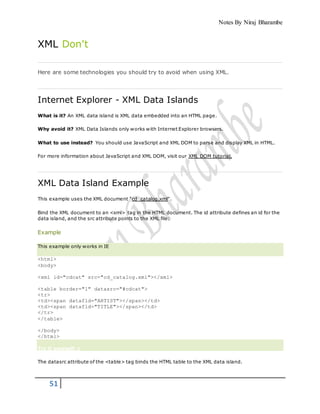

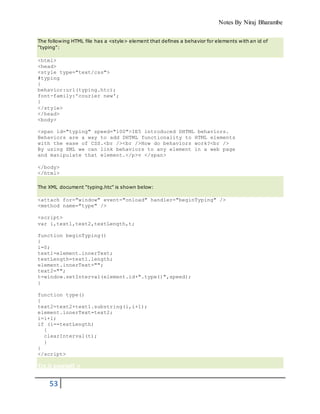


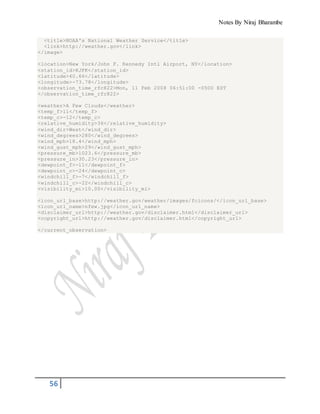



![Notes By Niraj Bharambe
60
E4X is an extension of JavaScript that adds direct support for XML. ECMA-357 (E4X) was standardized
in June 2004.
The ECMA organization (founded in 1961) is dedicated to the standardization of Information and
Communication Technology (ICT) and Consumer Electronics (CE). ECMA has developed standards for:
JavaScript
C# Language
International Character Sets
Optical Disks
Magnetic Tapes
Data Compression
Data Communication
and much more...
Without E4X
The following example is a cross browser example that loads an existing XML document ("note.xml")
into the XML parser and displays the message from the note:
Example
var xmlDoc;
//code for Internet Explorer
if (window.ActiveXObject)
{
xmlDoc = new ActiveXObject("Microsoft.XMLDOM");
xmlDoc.async=false;
xmlDoc.load("note.xml");
displaymessage();
}
// code for Mozilla, Firefox, etc.
else (document.implementation && document.implementation.createDocument)
{
xmlDoc= document.implementation.createDocument("","",null);
xmlDoc.load("note.xml");
xmlDoc.onload=displaymessage;
}
function displaymessage()
{
document.write(xmlDoc.getElementsByTagName("body")[0].firstChild.nodeValue);
}
Try it yourself »](https://image.slidesharecdn.com/xml-150323102007-conversion-gate01-150606072724-lva1-app6892/85/Xml-150323102007-conversion-gate01-60-320.jpg)

